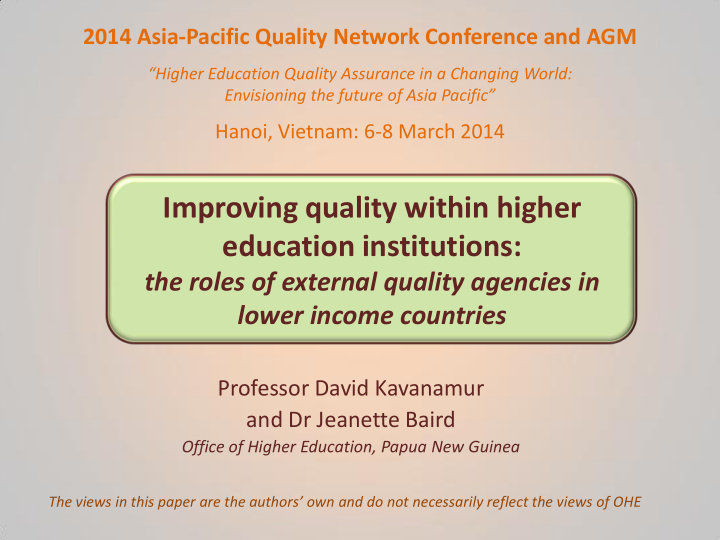



2014 Asia-Pacific Quality Network Conference and AGM “Higher Education Quality Assurance in a Changing World: Envisioning the future of Asia Pacific” Hanoi, Vietnam: 6-8 March 2014 Improving quality within higher education institutions: the roles of external quality agencies in lower income countries Professor David Kavanamur and Dr Jeanette Baird Office of Higher Education, Papua New Guinea The views in this paper are the authors’ own and do not necessarily reflect the views of OHE
Initial observations • Most LICs have the challenge of increasing access while improving quality in HE. They usually have limited resources to support HE. • If improving quality within HE institutions is the goal, then the dynamics of internal institutional change need to be understood. • EQAs in LICs need to adapt their methods and activities to increase the chances of positive institutional change, for efficiency as well as for effectiveness.
The challenge of limited resources / inputs Quality is not just about the quantity of resources and other inputs….. ‘… the efficiency of spending is more important than the amount of expenditures…institutional settings and governance structure play a considerable role in the way a given quantum of resources is spent and how it translates into efficient service delivery ’.* *Millot, B. (2012). Are Countries’ Investments in Tertiary Education Making a Difference? South Asia Human Development Sector Discussion Paper Series, No. 53. World Bank: Washington, DC: World Bank, p. 23
Outline of the argument EQAs in LICs need to adopt a broader remit than just the conduct of quality reviews. Three further areas to be embraced: 1. Ongoing scaffolding and support of quality improvement within institutions 2. Design of IQA mechanisms that are responsive to particular cultural norms and values , and 3. Help in wider reform of the relationship between government and higher education institutions. Examples from PNG and LICs.
Papua New Guinea • 7 million people • 800 languages • Three larger cities • Highlands and islands • Independence: 1975
PNG has a small tertiary sector: • 6 universities (4 State, 2 church) • 14 State nursing and teachers’ colleges • 7 State technical and business • Existing EQA for private schools providers but many do • Other church and non-profit not understand the colleges affiliated to universities requirements • Other for-profit providers (HE and • Uncertain EQA for State TVET) colleges • Different departments responsible • First round of EQA for different institutions reviews of universities nearly complete Current situation for EQA • Outdated legislative framework being replaced
What next after an EQA review? EQA reviews of themselves may provide little more than a mildly disruptive change for institutions without leading to sustained internal quality assurance regimes. Concerns: • Naivety by EQA over ease of making internal changes • Lack of knowledge within institutions about desired changes or how to implement them • ‘Signalling’ behaviour without genuine commitment.
Implications for EQAs in LICs Need for continuing support and ‘scaffolding’ to implement internal change: • By the agency • By other actors in-country, e.g. incentives, expertise • Donor agency assistance • Institutional twinning / normative pressure from HE institutions in other countries
Implications for EQAs in LICs cont’d Need to understand cultural norms and values that can affect change implementation. In a PNG context, relevant factors include: • High power distance / ‘bigman’ culture • Corruption / private gain • Stability favoured over change • Short-term rather than longer-term planning (uncertain external environment • No culture of evidence or strong M&E • Hierarchies of need: safety and security first.
IQA mechanisms that are responsive to cultural norms and values EQA should help reinforce IQA. But IQA implementation will be affected by national cultural norms and values. So, a further challenge for EQA is to help institutions to design IQA mechanisms that will work in the specific environment, taking account of the cultural factors already mentioned. Also need for EQA to tailor: • Training of reviewers • Interviewing styles.
EQA contribution to wider HE reform Quality is a product of factors both within and around higher education institutions. EQA is often a product of HE reform. However, it can also be a catalyst for further HE reform. The relationship between government and public institutions can have a profound impact in reinforcing or negating efforts to embed IQA. Relevant features: • Extent of sectoral coordination and cooperation • Effectiveness of accountability mechanisms • Funding models that reward institutions for output quality.
EQA as a catalyst for further HE reform in PNG
Crafting the roles of EQAs EQAs usually have a range of functions. EQA can be embedded within a Ministry or be a separate body (both models have advantages and disadvantages). In LICs, an EQA will be unlikely to ensure better quality unless it: • Supports HE institutions to implement recommendations • Takes account of cultural factors relevant to IQA • Works closely with other agencies on HE wider reform.
Further work • Cultural factors that affect IQA and change within HE institutions • EQA as assessment of institutional effectiveness? • EQA as a catalyst for wider reform of HE in LICs • Cooperative relations between EQAs and their parent Ministry : separation or integration?
Thank you!
Recommend
More recommend